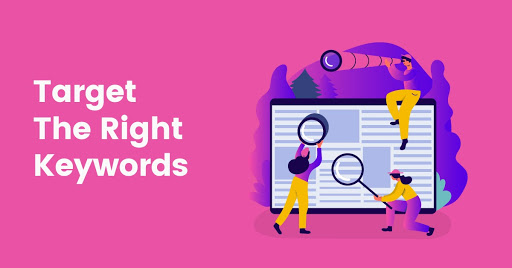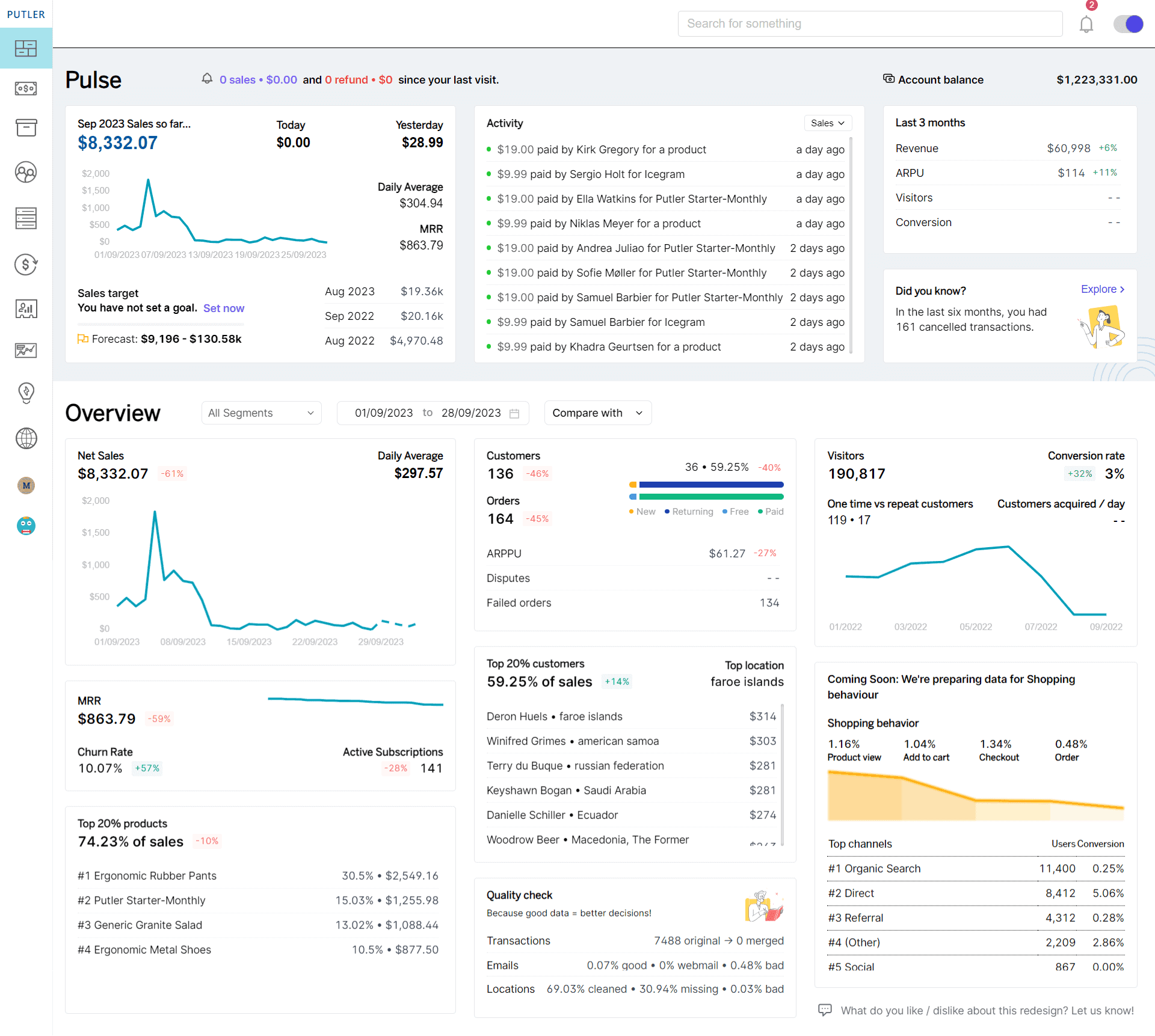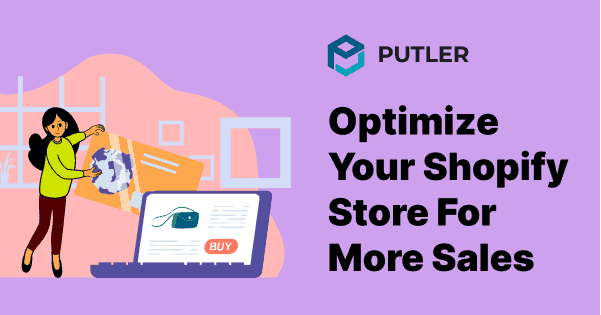While you may have ads out there, and social media pages spreading the word about your store, it’s important to optimize your store.
This is all about getting it more visible and likely to convert any natural traffic received.
Your store’s website should have a super performance if you’re to rank highly in search results.
The basic Shopify store has good SEO (Search Engine Optimization) at the ground level, but there are more changes you can make to your store to improve its ranking.
Let’s check them out.
How to optimize your Shopify store – Top Strategies
As we’ve established the importance of optimizing your store to increase visibility and conversions, let’s break down the strategies to take as you optimize your Shopify store for more sales.
By implementing these techniques, you’ll be able to maximize the performance of your Shopify store and improve its ranking in search results.
Streamline your website structure
Remove as many layers as you can between the homepage and a product’s page. If you already have categories, limit subcategories. Or just remove them altogether. Try a flat site architecture.
This makes it easier for search engines to scan your site for these product pages. Create special pages where customers can access any other important information. An example is your contact information and description.
Use an “About Us” page and a “Contact” page for this. These pages help to keep people around which can boost your ranking. They also make some shoppers more likely to buy if they know how to get in touch with you.
Target relevant keywords

Start off with a simple list of some major topics related to your products. Imagine what you’d search for if you were the customer. Check forums, social media hashtags, and other elements of competitors’ websites for possible keywords.
These could be in titles, meta descriptions, image alt-text, and more. Conduct searches and see how high up the list your site appears. Use tools like Ahrefs to get even more details on keywords and the statistics surrounding them.
Revisit your site and change your text fields like product names and such. Make them resemble the more common keywords suggested by the SEO tools used.
Keep making changes until you’re higher up on the first page of search results.
Improve user experience
This relates more to how customers feel when using your site. Shorten your loading time. Paste your URL into grading tools like Pingdom and find out how heavy the size is.
Note the speed and revisit the areas where the site has low grades. Put in place a more responsive design. With this one, your site adjusts properly to whatever device it’s being viewed on.
Uninstall any apps you no longer use. Replace some images with smaller ones that are fitting. Do away with sliders. Add Google Accelerated Mobile Pages (AMP) where the platform allows. This helps your store load faster on mobile devices.
Make these changes on every page where they are needed. Consider changing to a faster and more mobile-friendly theme. You can get great performance with some free Shopify themes.
Resize some CTA buttons like the “Add to Cart” to fit the full-screen width. Make sure it can be accessed without scrolling. These size and above-the-fold rearrangements will make your store pass the thumb zone test.
This means people using their thumbs on a small mobile screen are more likely to click on-site elements. These conversions get you closer to more sales.
Optimize your product pages
Pick out some of your best-performing pages and start there. Come up with a format for inserting keywords into title tags for categories. Proceed to your product names and find a way to blend the keywords into them and the other copy.
Place extra CTAs on these pages like “show more” or “view related products” to keep shoppers on the page or the site in general. Offer neat product photography with many angles.
Install powerful Shopify Apps
As you think about how to set up a Shopify store, research about add-ons, plug-ins, etc. The Shopify app store has numerous tools that can help with SEO. Know the specific goal you want to achieve.
Some tools help with images; others are about boosting speed. Try not to apply too many to do the same job just because you can get free ones. This can affect your store’s performance negatively.
Strengthen your link building strategy
These links are more about showing how you’re viewed in a larger pool of websites. The more backlinks you have, the better. Start off by picking out websites within your field.
They can be suppliers or manufacturers. Find out their policy on listing authorized retailers. Meet their targets and get mentioned on their site, with a link back to yours. This could be straight to a product or category page.
You can do the same with big industry voices and influential blogs. Do some investigation on sites with broken links. Suggest that they replace them with links to your site. This can be a win-win since it improves their SEO too.
Provide additional resources
Create slideshows and videos relating to your products. These can be demonstrations of how to use a product. They may also be simple unboxings showing the look and details of a product.
These help to keep people in the store and also make them more confident about the value they stand to get. They can also be used to point shoppers to other offers (discounts and promotions) on your site.
Another way to utilize them is through hosting reputable personalities in fields related to your products. For example, get popular performers or producers to talk about why they like certain music gear.
The goal is for them to share links to these resources with their followers.
Expand your content strategy
Go through your store and note a few products. Look for popular websites with content on topics related to those products. Contact them and find out their submission policies.
Put together some articles that are interesting and informative. Include your store within them and get them published. This can drive more traffic to your site from people who read that content and click on the links within it.
You can also do the same independently. Create a blog for your store. Update it regularly with new pieces. Some shoppers may be in your store but not quite convinced to buy yet. Make your blog available to them.
If some read an interesting piece from there talking about particular products, they might be led back to those pages. When you present yourself as a credible voice on a specific topic, some shoppers are more likely to buy from you.
Create effective landing pages

Landing pages are simpler pages usually aimed at producing one particular action. Give these pages good pictures. Write the value given clearly and boldly. Place a major CTA on the page, usually something like “Buy Now”.
The value may be presented after the CTA for example; “and save up to 20%”.
Exclude any features like newsletter signups that may distract the shopper. Make sure that your major ads link directly to these pages. They help mainly in getting a quick sale.
Here are a few other easy tips to try out for your store if you want to drive more sales:
- Get Your Products Shared: Have good-looking social media buttons on your pages. Place them where they don’t interfere with the rest of the information displayed. Encourage shoppers to share your listings.
Throw in a few offers where possible. Make this option available for carts and custom designs too. This may attract more people to your store. A good example is the Shareable Cart app for Shopify. - Fine-tune lead generation: Use well-timed pop-ups to collect emails. You can then use these to communicate with potential buyers and get more visits. The clicks help you rank higher eventually.
Another option is live chats that you can use to get shoppers to subscribe to Facebook Messenger lists and such. - Offer retaining features: Enable shoppers to save carts. This means you can get multiple visits as a shopper edits their cart and gets closer to making a purchase. You can also remove restrictions on account creation.
- Add Structured Data: With this additional information like star ratings and product availability, you can appear higher in results. Those who add things like “3-star”, “in stock” or “40 available” are more likely to see your listings.
Leverage Email Marketing Automation
Email marketing is a powerful tool that can drive repeated sales and help in engaging with customers. While acquiring new customers is a good thing, re-engaging the old ones can save costs and increase sales.
Now sending emails manually for each activity is a tedious job, you can certainly streamline things by automating the email sequence. With this, you can send emails to the customers based on their activities.
So for example, if a person has left something in the cart, the cart abandonment emails would sent automatically without your need.
The first thing you need to do before automating your email is segmentation.
Divide your email list into specific segments raised on their activities such as past purchases, browsing behavior, customer demographics, etc.
After segmentation, create email campaigns with tools like Icegram Express. There are different kinds of emails you can set up like abandoned cart reminders, post-purchase follow-up, re-engagement emails, welcome emails, etc.
With Icegram Express, you cannot only create attractive emails but also schedule automated campaigns with ease.
Capitalize on Customer Loyalty Programs
A well-structured loyalty program can also help you boost customer retention and increase lifetime value.
By rewarding your customers for repeat purchases social media shares or references you can create a sense of appreciation and motivation for them to keep coming back to your store.
To create a loyalty program you can select a loyalty program app that integrates smoothly with your Shopify store. A few examples are Smile.io or LoyaltyLion.
Using this app, you can set up a point-based system to reward your customers based on their specific actions such as making a purchase, signing up for a newsletter, or even writing a review.
Make sure that the rewards you are providing help you encourage repeat business. Additionally, you can also provide additional bonuses such as exclusive discounts, free product samples, early access to sales, etc.
Common mistakes that prevent sales despite high traffic in Shopify
Here are some common mistakes that can be the culprit of your low Shopify sales.
If your users cannot find what they are looking for they will not make a purchase.
A confusing or complex UI can frustrate your potential customers and cause them to leave your side even before making a purchase.
Therefore you need to make sure that your website is intuitive, simple, and easy to navigate.
Slow loading time
If you are not paying attention to your site speed, then take this point as a reminder.
Generally, if your website takes more than 5 seconds to load then there is a high chance that your visitors will bounce can leave the website.
You can use tools like Google Page Speed Insights to check your page loading speed and also find tips to improve it.
Lack of trust signals
If your website is missing its SSL certificates, complex return policy, or no customer reviews, then the visitors can leave your website due to a lack of trust.
Inadequate product description
If you don’t mention the specifications of your product carefully in the description then your visitors can find it difficult to make a decision.
A good description provides specifications, features, and usp can help them in making decisions.
Poor mobile optimization
The majority of Shopify users use mobile.
So, if your site is not mobile-friendly, your visitors can face difficulty in navigating your website.
Complicated checkout process
Despite adding your product to their carts, if visitors end up getting stuck in a long and confusing checkout process, they are most likely to abandon the product and leave your website.
Therefore, streamlining the checkout process and minimizing the number of steps is vital.
No clear CTA
CTA or calls to action is a prompt that asks users to take certain actions on your website.
If you are not mentioning it then your visitors can get confused as to what they need to do.
Uncover actionable insights with Putler’s analytics
In addition to the optimization techniques mentioned above, another powerful tool to consider for driving sales and gaining valuable insights is Putler.
Putler is an analytics and reporting platform specifically designed for Shopify stores.
It provides a comprehensive overview of your store’s performance, helping you make data-driven decisions to boost sales.

- Track key metrics: With Putler, you can track key metrics such as sales trends, customer behavior, and product performance. This data helps you identify areas of improvement and capitalize on sales opportunities.
- Real-time data visualization: Putler also allows real-time data visualization and reporting so you can easily spot trends and anomalies. It also helps you to make timely decisions and act faster in emergencies.
- Customer behavior analysis: By understanding your customers’ preferences and purchasing patterns, you can tailor your marketing strategies and product offerings to better meet their needs. This targeted approach helps you enhance your customer satisfaction and thereby boost sales through repeated purchases and referrals.
- Payment gateway integration: Putler also integrates with various payment gateways, allowing you to effortlessly sync your transactions and gain a holistic view of your revenue streams. It offers detailed insights into payment processing fees, refunds, and subscription revenues, helping you optimize your pricing strategies and streamline your financial operations.
- Advanced segmentation: Putler offers advanced segmentation capabilities that allow you to segment your customer base based on different criteria such as purchase history, location, and product preferences. This enables you to target specific customer segments with personalized marketing campaigns and promotions, increasing the likelihood of conversion and customer retention.
- Sales forecasting: Putler also helps you with sales forecasting. On the Sales dashboard, you can find future sales trends. You can also check the Time Machine dashboard to get some interesting insights to grow your business by 10x. These insights help you manage inventory better and also attract investors for scaling your business.
- Comprehensive analytics: With Putler, you can pull data from various sources and get a comprehensive view of your business. For example, if you are using Google Analytics to track traffic on your Shopify website, you can integrate it with Putler to get specific eCommerce metrics in addition to basic web traffic insights. You can even integrate Shopify’s in-built analytics tools with Putler for better insights.
- Multiple Shopify stores or multiple platform consolidation: Whether you are selling on multiple platforms or multiple Shopify stores, you can connect all in Putler to get a comprehensive picture in a single dashboard. You don’t have the juggle between tabs to keep an eye on everything. It’s just one dashboard with all the information.
In simple words, integrating Putler into your Shopify store can be a game-changer for driving sales and gaining valuable insights.
By harnessing the power of data analytics, you can optimize your marketing efforts, enhance customer experiences, and ultimately increase your store’s profitability.
In conclusion
Optimizing your Shopify store involves both on-site and off-site strategies.
Go beyond your website, and engage with forums, subreddits, and social media groups.
Understand the customer journey, leverage tools like Putler for analytics, and continuously refine your strategies to generate leads, retain traffic, and drive conversions.
Remember, optimization is an ongoing process for sustained success.
Regularly revisit your actions, especially when adding new products, to ensure sustained success.
FAQs
How to get sales fast on Shopify?
To get fast sales on Shopify, you can consider paid advertising, targeted promotions, and heavy discounts to attract customers. You can also optimize Shopify store’s SEO for better organic search visibility and use your social media connections to get traffic. Additionally, if you have an email list, you can utilize it to reach out to your potential or existing customers to boost your sales.
How do I attract customers to Shopify organically?
To get organic visitors on Shopify, you have to have to do a combination of different things. First, you have to invest your time and money in the SEO of your stores. Then you can work to enhance your presence on social media platforms. Additionally, you can also create content around the niche you are selling to drive more traffic to your Store
How do I make my Shopify store successful?
Shopify success is not something you can achieve in the short term. You have to follow a holistic approach. This includes delivering a seamless user experience on your store, regularly updating your product offerings, running sales, optimizing the store, and utilizing analytics tools like Putler to monitor performance and make data-driven decisions.
What steps can I take to improve the user experience on my Shopify store?
To improve the user experience of a Shopify store, you can follow these steps:
- Optimize your page loading speed
- Ensuring mobile responsiveness
- Simplifying navigation
- Streamlined checkout process.
- And regularly do tests and update websites accordingly.
What are some effective ways to improve Shopify store conversion rates?
If your Shopify store is getting a good amount of visitors but not converting well you can follow these these tips to optimize your shop:
- Product page: Work on your product page and ensure that they have high-quality images detailed descriptions and clear CTAs. You can also add customer testimonials to increase the trust of the visitors.
- Streamline the checkout process: You can also simplify the checkout process and reduce the number of steps to reduce cart abandonment rates.
- Implement retargeting campaigns: you can also run ads to reach customers who have visited your store but did not complete a purchase. You can offer discounts to encourage them to complete their transaction.
- A/B test: While some strategies may work for one store and another for others, you can only find your way till you try out them. So keep on testing different strategies and see what best resonates with your customers.

